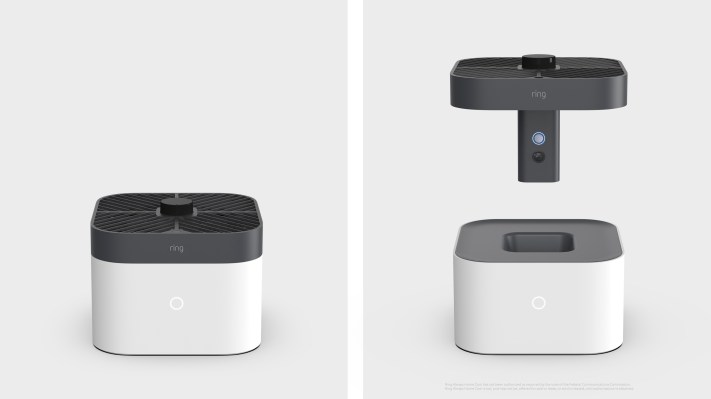Ring built its entire business on reinventing the doorbell — and now it’s taking a similar approach to the humble home security camera, with the Ring Always Home Cam, set to be available sometime next year. You might not guess from its name, but this security camera is actually mobile: It’s a drone that flies autonomously throughout your home, to provide you with the view you want of whatever room you want, without having to have video cameras installed in multiple locations throughout your house.
The Always Home Cam is a diminutive drone that can be scheduled to fly preset paths, which you lay out as a user. The drone can’t actually be manually flown, and it begins recording only once its in flight (the camera lens is actually physically blocked while it’s docked) — both features the company says will help ensure it operates strictly with privacy in mind. Always Home Cam is also designed intentionally to produce an audible hum while in use, to alert anyone present that it’s actually moving around and recording.
As you’d expect, the Always Home Cam doesn’t have the exposed rotors you’d see on a drone designed for use in outdoor open spaces. It has a plastic border and grills that enclose those for safety. It’s also small, at 5″x 7″x7″, which is useful for safety of both people and household objects.
I spoke to Ring founder and CEO Jamie Siminoff about why they decided to create such an ambitious, unorthodox home security camera — especially given their track record of relatively down-to-Earth, tech-enabled versions of tried-and-tested home hardware like doorbells and floodlights. He said that it actually came out of user feedback — something he still personally pays close attention to, even now that Ring is part of the larger corporate apparatus of Amazon. Siminoff said that a lot of the feedback he was seeing was from customers who wished they’d either been home or been able to see when some specific thing happened at a specific place in their house, or that they wanted a camera for a particular room, but only for certain times — and then a different camera in a different room for others.
“It’s not practical to have a camera at every angle in every room of the home,” he said. “Even if you had unlimited resources, I think it’s still not practical. What I love about the Always Home Cam is that it really does solve this problem of being one cam for all — it allows you to now see every angle of the home, in every part of the home.”
Drones are also not Ring’s main business, and yet the Always Home Cam will be available at the relatively low price of $249 when it becomes available, despite the technical challenges of creating a small aircraft able to operate indoors safely and fully autonomously. I asked Siminoff how Ring was able to achieve that price point in a category that’s outside its core expertise, with a design developed fully in-house.
“As the technology has kind of aged, a lot of these parts come down in price,” he said. “There’s also a lot of price compression happening because auto manufacturers are using a lot of these parts now at higher volumes, because to have an autonomous drone, you need some similar things to autonomous cars. Obviously, it’s not the same exact parts, but all of those costs have been coming down, and we were able to go with a fresh perspective to it. But I also challenged the team when we came up with this, that this has to be affordable.”
The Ring Always Home Cam will also work with Ring Alarm to automatically fly a pre-set path when an alarm is triggered. You’re able then to stream the video live to your mobile device via the Ring app. In many ways, it does seem like a natural extension of the Ring ecosystem of products and services, but at the same time, it also seems like something out of science fiction. I asked Siminoff if he thinks consumers are ready to take this kind of technology seriously as something that’s part of their daily lives.
“I think it is sort of something that is, in some ways, way out there,” he acknowledged. “What I love about it, though, is that it’s what happens when you just take the constraints away of this linear thinking. I love that we are doing stuff from really looking at the need backward, and then what technology exists, and ask what can we build? It’s really exciting for me to be able to do something and put our stamp on something that is an industry first.”

